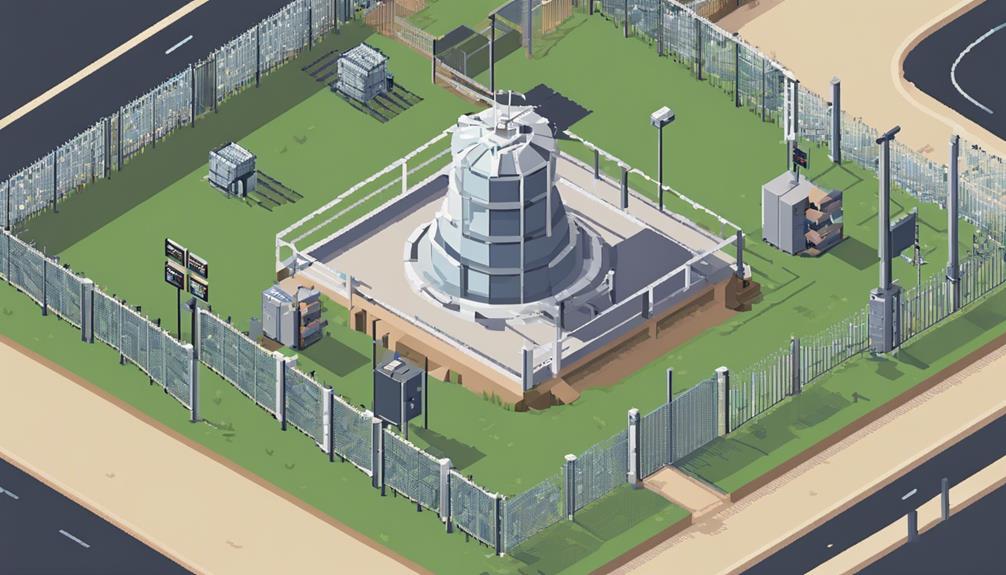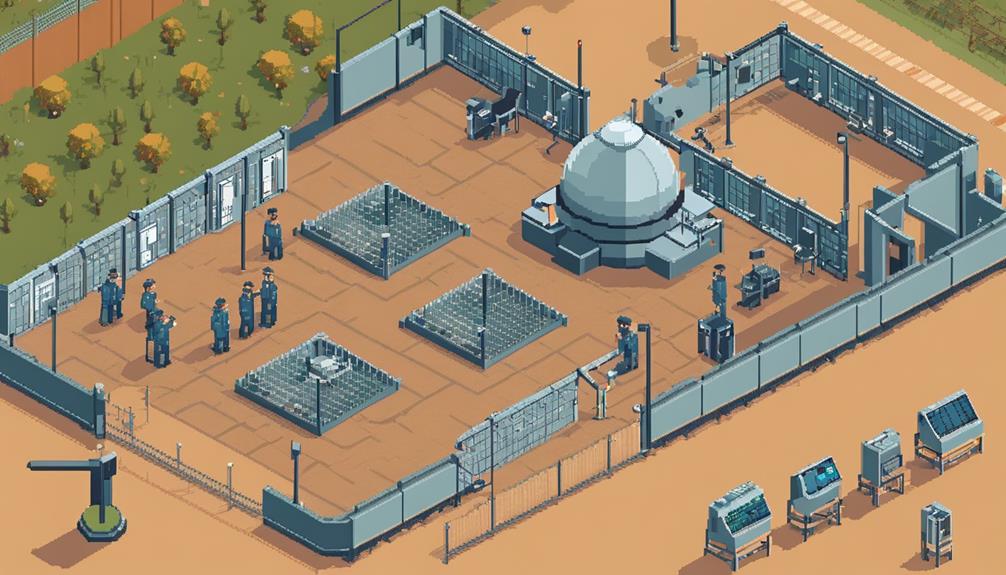Ground station security measures are a critical component of ensuring the integrity and confidentiality of satellite communications. From sophisticated encryption techniques to stringent access controls, the protection of ground stations is paramount in safeguarding sensitive information and maintaining operational resilience. However, as technology advances and cyber threats evolve, the challenge of securing ground stations becomes increasingly complex. In light of these considerations, it is imperative for organizations to continuously assess and enhance their security measures to mitigate potential risks and uphold the reliability of satellite communications.
Key Takeaways
- Ground stations employ encryption protocols and physical security measures for data protection.
- Cyber threat detection tools and network security practices safeguard ground station operations.
- Encryption protocols like AES and RSA ensure secure satellite communication.
- Compliance with ISO/IEC 27001 standards enhances ground station security and operational integrity.
Importance of Ground Stations in Security

Ground stations serve as critical infrastructure for ensuring the secure and reliable communication between satellites and defense networks, playing a pivotal role in safeguarding military operations. These stations are fundamental in establishing a robust communication link that facilitates the control and management of satellite operations. By acting as intermediaries between satellites and ground-based systems, ground stations enable the seamless transmission of crucial data, voice, and video signals essential for military activities.
The control and monitoring of satellites from ground stations are paramount for ensuring the efficiency and effectiveness of satellite operations. Ground stations provide the necessary access points for transmitting commands to satellites and receiving telemetry data, allowing for real-time adjustments and maintenance of satellite systems. Additionally, the security protocols implemented at ground stations are vital in safeguarding the integrity and confidentiality of the communication channel between satellites and defense networks.
To maintain the robustness of the communication link, ground stations are equipped with high-frequency antennas and advanced technology that ensure reliable connectivity and data transfer. These stations are designed to withstand various environmental conditions and interference to guarantee uninterrupted signal reception and transmission. Overall, the role of ground stations in ensuring secure and efficient communication with satellites is indispensable for the success of military operations and national defense strategies.
Data Protection Measures at Ground Stations
Implementing stringent data protection measures is crucial at ground stations to ensure the secure transmission and integrity of sensitive information between satellites and defense networks. Ground stations employ various advanced technologies and protocols to safeguard data and prevent unauthorized access:
- Encryption Protocols: Ground stations utilize encryption protocols to secure data during transmission, ensuring that information is only accessible to authorized parties with the decryption keys.
- Authentication Algorithms: Advanced authentication algorithms are implemented at ground stations to verify the identity of users and devices accessing the network, preventing unauthorized access to sensitive data.
- Data Integrity Measures: Ground stations have robust data integrity measures in place to detect and prevent any unauthorized tampering or modification of sensitive data, maintaining the accuracy and reliability of the information being transmitted.
In addition to these measures, redundancy mechanisms are employed to create backups of data, ensuring its availability and integrity in case of transmission errors or failures. Secure communication channels are established to protect data from interception or manipulation by unauthorized entities, enhancing the overall security posture of ground stations and the networks they connect with. By employing these data protection measures, ground stations can effectively mitigate the risks of data breaches, interception, and unauthorized access, safeguarding critical information vital for national security and defense operations.
Cyber Threat Detection and Prevention

To fortify the resilience of ground station networks against evolving cyber threats, a comprehensive approach encompassing advanced intrusion detection systems, regular security audits, and real-time monitoring tools is indispensable. Ground stations leverage advanced intrusion detection systems to continuously monitor network traffic and swiftly identify potential cyber threats. These systems play a crucial role in proactively detecting and mitigating intrusion attempts, ensuring the security of sensitive data and critical operations.
In addition to intrusion detection systems, ground stations implement rigorous security audits and vulnerability assessments to uphold a secure environment. By conducting regular audits, vulnerabilities and weaknesses within the network infrastructure can be promptly identified and addressed, minimizing the risk of exploitation by malicious actors. Furthermore, the utilization of firewalls and access control mechanisms is essential in preventing unauthorized access to vital systems and data repositories within ground stations.
Real-time monitoring tools are also deployed to detect anomalies and suspicious activities that may indicate cyber intrusions. These tools enable operators to respond swiftly to potential threats, enhancing the overall security posture of ground station networks. Moreover, continuous security training and awareness programs for staff members are instrumental in enhancing cyber threat detection and prevention capabilities, ensuring that personnel remain vigilant and well-equipped to identify and respond to evolving cybersecurity challenges effectively.
Encryption Protocols for Satellite Communication
Encryption protocols for satellite communication are fundamental in securing data transmission, implementing key exchange protocols, and verifying signal authenticity. These protocols serve as the backbone of data confidentiality, ensuring that sensitive information remains protected during satellite communication processes. By employing advanced encryption standards like AES and RSA, satellite systems can fortify their defenses against unauthorized access and maintain the integrity of transmitted data.
Secure Data Transmission
Data confidentiality in satellite communication is ensured through the utilization of encryption protocols, such as the widely adopted Advanced Encryption Standard (AES), which encodes information during transmission to safeguard sensitive data exchanged between satellites and ground stations.
- Encryption protocols prevent unauthorized access to critical information.
- They convert plaintext data into ciphertext that requires the correct decryption key.
- Secure data transmission is crucial for protecting classified military communications and ensuring the integrity of data transferred over satellite networks.
Implementing strong encryption protocols in satellite communication systems fortifies defenses against interception, data tampering, and eavesdropping, thereby enhancing the overall cybersecurity posture of the network.
Key Exchange Protocols
Secure communication channels between satellites and ground stations rely on key exchange protocols, such as RSA, Diffie-Hellman, and ECC, to establish and maintain the confidentiality and integrity of data transmitted over satellite networks. These encryption protocols facilitate the secure generation, exchange, and verification of cryptographic keys, ensuring that unauthorized access is prevented. Implementing robust key exchange protocols is crucial for protecting sensitive information from interception and tampering.
—
| Cryptographic Keys | Encryption Protocols | Secure Communication |
|---|---|---|
| RSA | Diffie-Hellman | ECC |
| Generation | Exchange | Verification |
Signal Authentication Methods
Utilizing cutting-edge signal authentication methods in satellite communication ensures the integrity and confidentiality of transmitted data, safeguarding against unauthorized access and enhancing overall security measures.
- Encryption protocols secure data transmission in satellite communication networks, protecting sensitive information from interception.
- Authentication mechanisms verify the origin and integrity of signals, establishing secure communication channels between satellites and ground stations.
- Implementing robust encryption techniques helps mitigate the risk of data breaches or cyberattacks, maintaining the confidentiality and integrity of critical data exchanged in satellite communication.
Physical Security Measures at Ground Stations
Ground stations employ a comprehensive array of physical security measures, including perimeter fencing and access control systems, to restrict unauthorized entry and safeguard critical infrastructure. Surveillance cameras and security guards are often deployed to monitor and protect the premises. Biometric authentication methods and security badges are utilized to ensure that only authorized personnel have access to sensitive areas within the ground stations. Secure storage facilities are also implemented to safeguard equipment, data, and communication systems from physical threats.
The following table provides an overview of the key physical security measures commonly found at ground stations:
| Security Measure | Description | Example |
|---|---|---|
| Perimeter Fencing | Fencing around the premises to prevent unauthorized access. | High-security chain-link fencing |
| Access Control Systems | Systems that regulate and monitor entry to the facility. | Keycard access control system |
| Surveillance Cameras | Cameras strategically placed to monitor activities and enhance security. | PTZ cameras for real-time monitoring |
| Security Guards | Trained personnel stationed at the ground station to provide physical security. | 24/7 on-site security presence |
Ground stations prioritize the implementation of these measures alongside regular security audits and risk assessments to identify vulnerabilities and ensure the continuous enhancement of physical security protocols.
Network Security Best Practices

When it comes to ensuring network security at ground stations, implementing robust encryption protocols such as AES-256 is crucial for safeguarding data in transit. Additionally, the use of multi-factor authentication adds an extra layer of protection by requiring multiple forms of verification to access sensitive systems. Regular updates, vulnerability assessments, penetration testing, and intrusion detection systems are all essential components of a comprehensive network security strategy to defend against emerging cyber threats.
Secure Network Access
To enhance network security, implementing strong authentication mechanisms such as two-factor authentication is crucial for secure network access.
- Network Segmentation: Isolating critical systems can prevent potential threats from spreading across the network.
- Regular Security Audits and Vulnerability Assessments: Identifying and addressing weaknesses in the network is essential for maintaining a secure environment.
- Firewalls and Intrusion Detection Systems: Monitoring and controlling network traffic can help detect and prevent suspicious activities that may compromise network security.
Training personnel on secure access practices is also vital to mitigate social engineering attacks and unauthorized entry attempts. By incorporating these measures, ground stations can bolster their defenses against cyber threats and ensure the integrity of their network infrastructure.
Data Encryption Methods
Utilizing advanced data encryption methods is paramount in safeguarding sensitive information exchanged between satellites and ground stations in satellite networks. Encryption techniques such as AES (Advanced Encryption Standard) play a crucial role in ensuring secure communication and preventing unauthorized access to confidential data. Additionally, protocols like SSL/TLS (Secure Socket Layer/Transport Layer Security) are commonly employed to encrypt data transmissions in satellite operations. By implementing strong cryptographic techniques, ground stations can maintain the confidentiality and integrity of the information shared within the satellite network. This proactive approach to data encryption enhances security measures and mitigates potential risks associated with cyber threats in satellite communications.
| Encryption Algorithm | Secure Communication Protocol | Importance |
|---|---|---|
| AES | SSL/TLS | Safeguarding sensitive data |
| Cryptographic Techniques | Data Transmission Security | Preventing unauthorized access |
| Confidentiality | Integrity Maintenance | Cybersecurity enhancement |
Incident Response Strategies for Ground Stations
Ground stations must establish robust incident response strategies to effectively address and mitigate security breaches within their satellite communication networks. When devising incident response strategies, several key elements should be considered:
- Detection and Analysis: Ground stations need to have mechanisms in place for promptly detecting security breaches within their satellite communication networks. This involves continuous monitoring of network activities and the implementation of advanced intrusion detection systems to identify potential threats.
- Response and Impact Minimization: Once a security breach is detected, ground stations must have predefined procedures for responding to the incident. Rapid response is crucial to prevent further damage and minimize the impact on the satellite communication network. Immediate isolation of affected systems and containment of the breach are essential steps in this phase.
- Drills and Expert Collaboration: Regular drills and exercises should be conducted to evaluate the effectiveness of the incident response strategies. These drills help in identifying weaknesses and areas for improvement. Moreover, collaboration with cybersecurity experts and relevant authorities is vital for obtaining the necessary support and expertise in handling and resolving security incidents effectively. By working closely with experts in the field, ground stations can enhance their incident response capabilities and better protect their satellite communication networks.
Compliance Standards for Ground Station Security

Establishing and maintaining compliance with recognized standards such as NIST SP 800-53 and ISO/IEC 27001 is paramount for ensuring the robust security of ground station operations. These compliance standards provide guidelines for implementing security controls and managing risks effectively. NIST SP 800-53 specifically focuses on federal information systems, while ISO/IEC 27001 is an international standard for information security management. By adhering to these standards, ground stations can meet industry best practices and regulatory requirements, thereby enhancing their overall security posture.
Compliance Standards Overview
| Compliance Standards | Focus Area | Key Features |
|---|---|---|
| NIST SP 800-53 | Federal Information Systems | Guidelines for security controls implementation |
| ISO/IEC 27001 | Information Security Management | International standard for security management |
Implementing security controls based on NIST SP 800-53 and ISO/IEC 27001 helps ground stations mitigate risks, protect sensitive data, and ensure operational continuity. It also demonstrates a commitment to upholding stringent security measures in line with established standards. By aligning with these compliance frameworks, ground stations can proactively address security vulnerabilities and uphold the integrity of their operations.
Future Trends in Ground Station Security
Incorporating advanced automation technologies is a key aspect of the evolving landscape of ground station security. Future trends in ground station security are driven by innovations aimed at enhancing efficiency, reliability, and overall performance. Key developments in this field include:
- Advancements in Antenna Technology: The adoption of phased-array antennas in ground stations will revolutionize communication capacity and flexibility. These antennas allow for dynamic beam steering, enabling ground stations to establish and maintain connections with multiple satellites simultaneously.
- Integration of Artificial Intelligence Algorithms: Artificial intelligence algorithms will play a pivotal role in optimizing communication performance and enhancing security measures within ground station operations. These algorithms can analyze vast amounts of data in real-time, identifying potential threats and anomalies to preempt security breaches effectively.
- Enhanced Network Management Systems: The development of sophisticated network management systems will provide crucial insights into signal quality and performance metrics. These systems enable continuous monitoring and control of network connectivity with satellites, ensuring optimal performance and security of ground station operations.
Frequently Asked Questions
What Do Ground Stations Measure?
Ground stations measure various parameters critical to communication, such as signal strength, data transfer rates, latency, and network traffic. They also monitor satellite positioning and trajectory. These measurements enable efficient connectivity, performance optimization, and anomaly detection. Incorporating data encryption, access control, authentication methods, and emergency procedures enhances security. Additionally, utilizing surveillance systems, remote monitoring, and network monitoring helps safeguard against signal interference, cyber threats, and ensure physical security.
What Are the Basics of Ground Stations?
Ground stations, integral to satellite communication, consist of sophisticated architecture involving high-frequency antennas for efficient data transmission. Signal interference is mitigated through advanced antenna technology. These stations enable remote monitoring, ensuring network connectivity and prompt maintenance. Emergency response protocols are in place, considering environmental factors. Ground stations form the backbone of satellite operations, facilitating reliable data exchange and communication with orbiting spacecraft.
What Is the Purpose of the Ground Station?
The primary purpose of a ground station is to facilitate efficient data transmission and signal reception between satellites and ground-based networks. Additionally, ground stations play a crucial role in tracking satellites, monitoring their orbits, considering weather conditions for optimal communication, implementing security protocols, enabling remote access, maintaining backup systems, strategically placing antennas for effective communication, and ensuring a consistent power supply to support uninterrupted operations.
How Do Satellites Communicate With Ground Stations?
Satellites communicate with ground stations via high-frequency antennas utilizing advanced technology. This process involves the transmission and reception of satellite signals for data, voice, and video transmission. Antenna technology plays a critical role in ensuring signal reception and minimizing interference. Communication protocols, frequency bands, satellite tracking systems, and signal encryption are employed to maintain secure and reliable data transmission between satellites and ground stations, ensuring transmission security.

